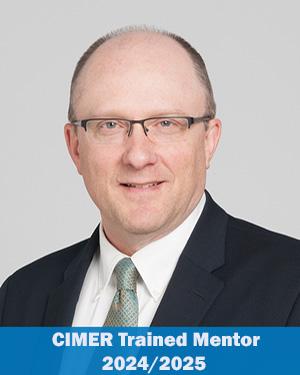Research News
12/12/2023
Researchers ask why adults don’t respond to allergy exposure therapy by studying preschoolers that do
As Cleveland Clinic’s Food Allergy Center offers care for life-altering allergies, it paves the way for further potential treatments.

Paul Karell, MD-PhD student and Thaddeus Stappenbeck, MD, PhD, Chair, Department of Inflammation & Immunity
For every approved treatment, there's a large percentage of patients who benefit. But there are also some who don't see the same effects. That's where research comes in.
As Cleveland Clinic's Food Allergy Center of Excellence (FACE) continues to provide life-changing exposure therapies to cure peanut allergies in most patients under four years old, a team of physicians and researchers are working to better understand why the remaining 20% of preschoolers – and 100% of patients over age 5 – don't achieve the same results. The effort holds potential to extend successful treatments to patients who otherwise would have no options and to answer long-unknown questions about our immune system.
To provide those options, we need to understand how exposure therapy changes the ways our immune system responds to potential threats. Allergy symptoms occur when our immune system cannot differentiate something safe, like a peanut, from a dangerous pathogen. Exposure therapies aim to cure allergies by building up "immune tolerance," and training the immune system not to respond to these harmless materials.
"We've come leaps and bounds in figuring out some of the most fundamental aspects of immunology, but we don't understand its dynamics," says Paul Karell, an MD-PhD student in the laboratory of Thaddeus Stappenbeck, MD, PhD, chair of the Department of Inflammation & Immunity. "Immune tolerance is a frontier of immune system research. We just don't yet know how it works."
That's why Food Allergy Center Director Sandra Hong, MD, and Associate Director Jaclyn Bjelac, MD, both physicians, teamed up with Karrell and Dr. Stappenbeck, whose lab specializes in the immune system and the intestine. The group is working to compare patient data from successful and unsuccessful treatments to gain insight into immune tolerance and the immune system as a whole.
"This is an exciting partnership between a very talented clinical team and biomedical researchers," Dr. Stappenbeck says. "This project highlights the immense potential of clinicians and researchers working together to celebrate the success of a clinical treatment by finding the answers to expand its use."
Starting with success
The success of current oral exposure therapies was built on what we know about the immune system and immune tolerance. Until we learn more about tolerance, we cannot find the answers to basic questions like:
How does exposure cure allergies in the first place? Why does it only seem to work in patients under four years of age? Why doesn't exposure therapy work in all patients under four? What role does the immune system play? Can we tweak our approach or layer in additional treatment to benefit other patients with the treatment?
Karrell, who is spearheading the collaboration, says the project is still in its early stages. Even so, he knows where he wants to look first: our gut.
A gut feeling
Preclinical data from multiple labs has already established ties between immune tolerance and the bacteria that live in our intestine, or the gut microbiome.
Karrell emphasizes that despite the promising lead, his team still needs to look beyond the gut using patient observations and samples. Looking at overall immune differences between patients who do and do not respond to treatment will provide more information on what these mechanisms are and how they work. Karell and Dr. Stappenbeck hope to identify key factors that physicians can reach with medication or other interventions to make these therapies effective.
Designing the project and translating clinical experience to the bench is a fundamental part of Karrell's training as a physician-scientist. Even in these early stages of research, Karrell says that working with Drs. Bjelac and Hong is a constant reminder of why investigating unknowns at the lab bench is critical to patient care.
"Before I worked directly with patients, I had never seen firsthand how disease pathology affects a person's livelihood," he says. "I want to address clinical problems through my research – hearing how everyone on this team talks about this problem and how much it affects patients is a great experience and a motivator."
Featured Experts
News Category
Related News
Research areas
Want To Support Ground-Breaking Research at Cleveland Clinic?
Discover how you can help Cleveland Clinic save lives and continue to lead the transformation of healthcare.
Give to Cleveland Clinic